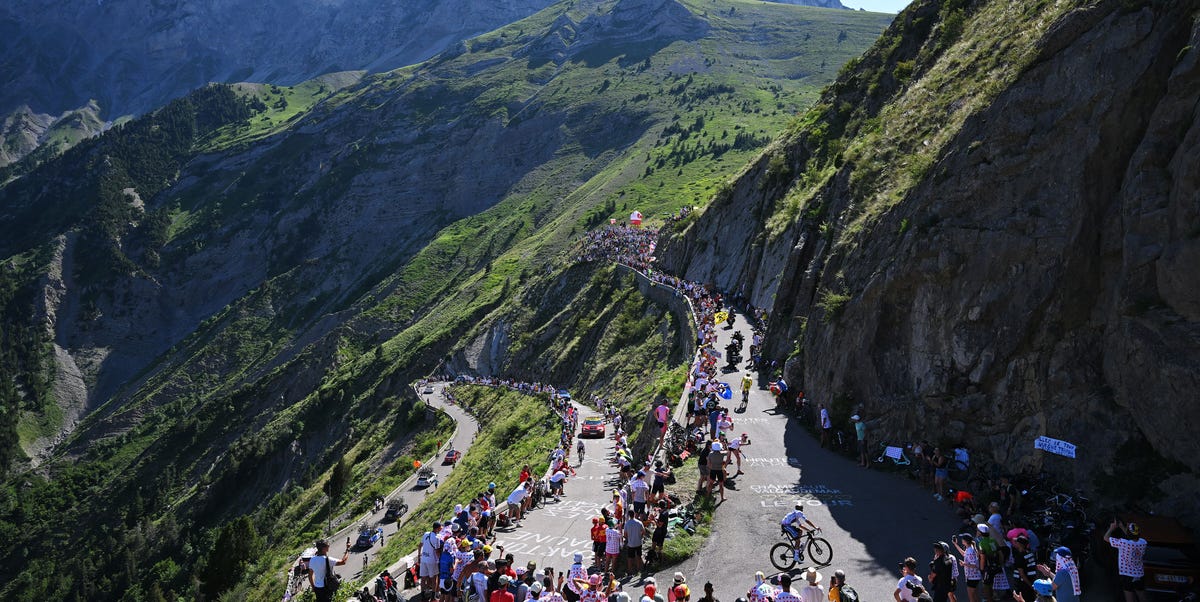The 2025 men’s Tour de France begins on Saturday, July 5th in Lille, and all signs point to it being one of the “climbiest” in the men’s Tour’s 112-year history–literally. To mark the 50th anniversary of the Tour’s King of the Mountains competition, the organizers have constructed a route with over 50,000 meters of elevation gain, which means lots of opportunities for the riders hoping to animate the race when the road goes uphill–and lots of stages that fans won’t want to miss.
In total, the 2025 Tour de France covers 3,338.8 kilometers (2,070 miles) spread over 21 stages, with 7 flat stages, 6 hilly stages, 6 mountain stages (with 5 summit finishes), and 2 individual time trials (one of which finishes atop a mountain). And while every stage of the 2025 Tour de France offers something you won’t want to miss, here are six stages that we think will be exceptionally exciting, so mark them in your calendars now–and if you miss something, don’t say we didn’t warn you.
And no matter which stages you decide time to watch the Tour live–even if you’re lucky and can watch all 21–make sure you head right to Bicycling.com each day for post-stage analysis and updates from me and the rest of the Bicycling team.
Stage 6
Bayeux to Vire Normandie
Thursday, July 10th – (201.5KM)
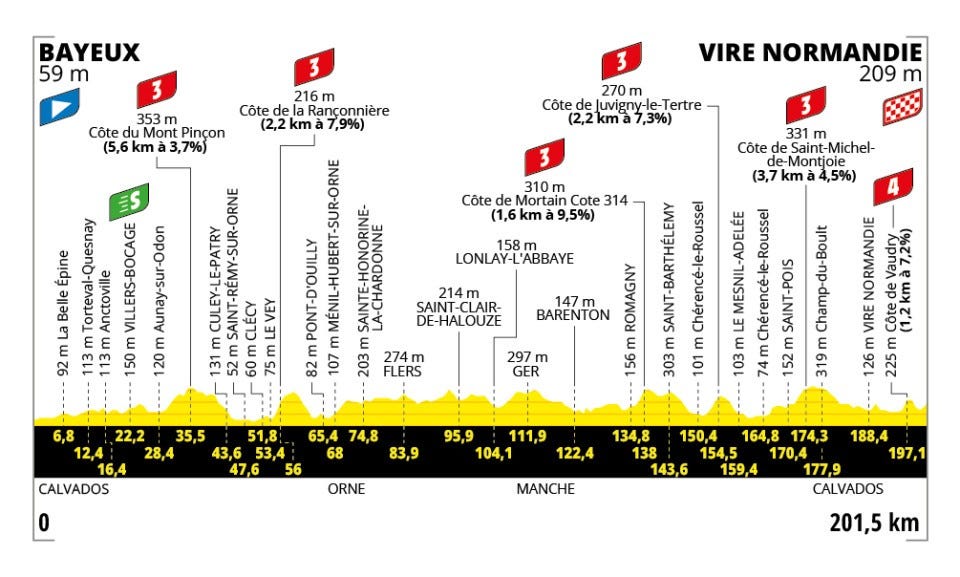
Le Tour De France
50,000 meters of elevation gain is a lot of climbing, so to achieve their goal, the organizers have filled the first half of the Tour with stages jammed with short, punchy climbs–many of which come inside the final hour of racing. That means lots of opportunities for riders hoping to wear the polka dot jersey jersey as the leader of the KOM competition, exciting stage finishes, and perhaps one or two opportunities for the Tour’s General Classification contenders to try and cause some chaos before the big mountains come later in the Tour.
Enter Stage 6, which clocks in at 201.5 kilometers, making it the second-longest in this year’s Tour. With six categorized ascents (and several other uncategorized ramps and hills), the stage runs right through the heart of “Norman Switzerland,” a hilly region in northern France known for its punchy climbs and tight roads. In all, Stage 6 boasts over 3,500 meters of elevation gain on the day, a hefty total given that this is the first week of the Tour.
And the stage comes right after the Tour’s first individual time trial. On one hand, that means we could see a breakaway go the distance if the GC contenders–perhaps satisfied with their results the day before–let a large group of one-day Classics specialists (who most likely “rested” during the time trial in order to be at their best for Stage 6) head up the road to fight for the win.
Related Story
But Stage 6 could also offer a chance for a GC contender–say, Slovenia’s Tadej Pogačar (UAE Team Emirates)–to launch a surprise attack. The stage resembles a shorter version of Liège-Bastogne-Liège, a hilly one-day race through the Belgian Ardennes, a race that Pogačar’s won three times. If the Slovenian lost time to his rivals in the time trial–or even if he gained time and senses an opportunity to strike while the iron is still hot–he could go on the offensive to try and extend his advantage.
Stage 10Ennezat to Le Mont-Dore Puy de Sancy
Monday, July 14 – (165.3KM)
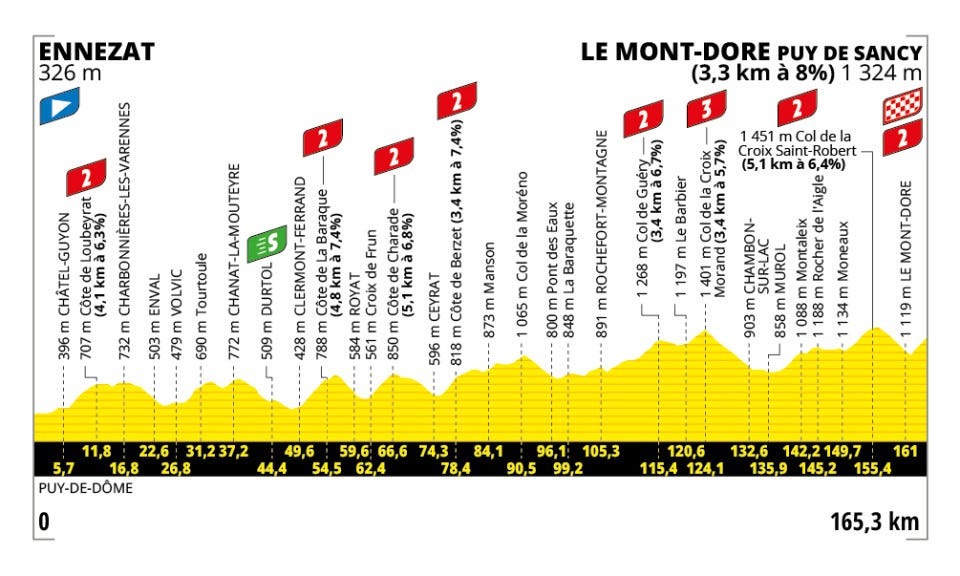
Le Tour De France
The Tour’s organizers always plan something explosive for Bastille Day, and this year they’ve really devised something exciting (for the fans) and fearsome (for the riders): a 165KM stage through the Massif Central with eight–yes, eight–categorized climbs, including a record seven Category 2 ascents.
Stages through the Massif Central, a region in the heart of south-central France that’s known for high temperatures, technical roads, and the jagged climbs, always produce exciting racing. Take last year’s Stage 11, a 211-kilometer-stage from Évaux-les-Bains to Le Lioran that exploded when Pogačar attacked three climbs from the finish–only to be joined and then outsprinted by Denmark’s Jonas Vingegaard (Visma-Lease a Bike). It was one of the most dramatic stages in the entire 2024 Tour de France.
This year’s Stage 10 is much shorter at only 165 kilometers, which means the climbs are more concentrated. From the start there are only a few kilometers of flat roads before the climbing begins–and then never really stops. Expect a fierce battle to join the breakaway as stage hunters and riders hoping to scoop up points in the Tour’s KOM competition try to escape. The peloton will be selective about which riders get up the road, so the first hour of racing will be fast and hard as riders attack and counter-attack repeatedly, trying to get the right “mix” in the eyes of the Tour’s heads of state. (Say a prayer for the sprinters just hoping to make it to the finish before the time cut.)
Once the breakaway has escaped the race will be hard to control as the race winds its way through the volcanic peaks of the Auvergne, with the roads always climbing–or descending (but mostly climbing)–all the way through to the finish.
The stage should be decided on the final two summits: the Category 2 Col de la Croix Saint Robert at 9.5 kilometers to-go; and then the Category 2 to the finish line on the Puy de Sancy, an extinct volcano that’s now the highest summit in the region. Both of these final climbs are short, but incredibly steep, and they’ll provide the perfect launchpads for riders hoping to win the stage, or more importantly, shake-up the GC before heading into the Tour’s first Rest Day.
Stage 12Auch to Hautacam
Thursday, July 17 – (180.6KM)
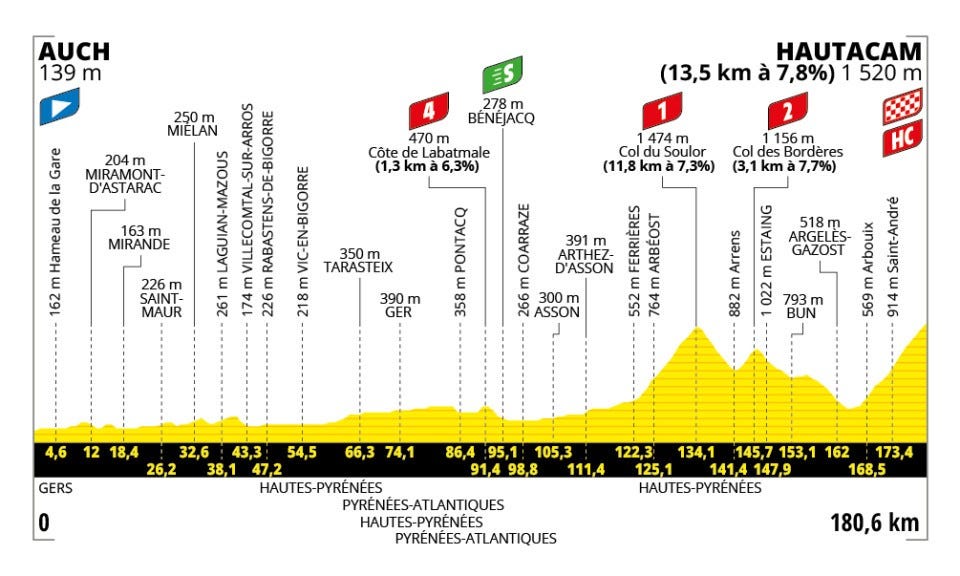
Le Tour De France
The Tour’s second week takes the riders into the Pyrenees for three mountain stages that all end with summit finishes (including Stage 13, a mountain time trial up the Hors catégorie or “Beyond Category” climb to Peyragudes).
But the suffering begins with Stage 12, a 180.6-kilometer stage that begins in Auch and ends on the famous climb to Hautacam, an ascent that always produces fireworks. The stage’s four categorized climbs are back-loaded into the second half of the stage, which means a breakaway should build a large early lead only to be reeled in by the GC favorite’s teams on or near the final climb.
The 2025 Tour’s first “Beyond Category” ascent, the climb to the Hautacam ski resort is 13.5-kilometer long with an average gradient of 7.8-percent–and several pitches that go above 10-percent halfway up the mountain.
Even with two more hard days in the mountains still to come, expect the Tour’s GC favorites to throw-down on the climb to Hautacam, with the first attacks possibly coming from Pogačar, who won’t hesitate to try and put Vingegaard and Belgium’s Remco Evenepoel (Soudal-Quick Step) on the defensive heading into the next two stages.
Stage 14Pau to Luchon-Superbagnères
Saturday, July 19th – (182.6KM)
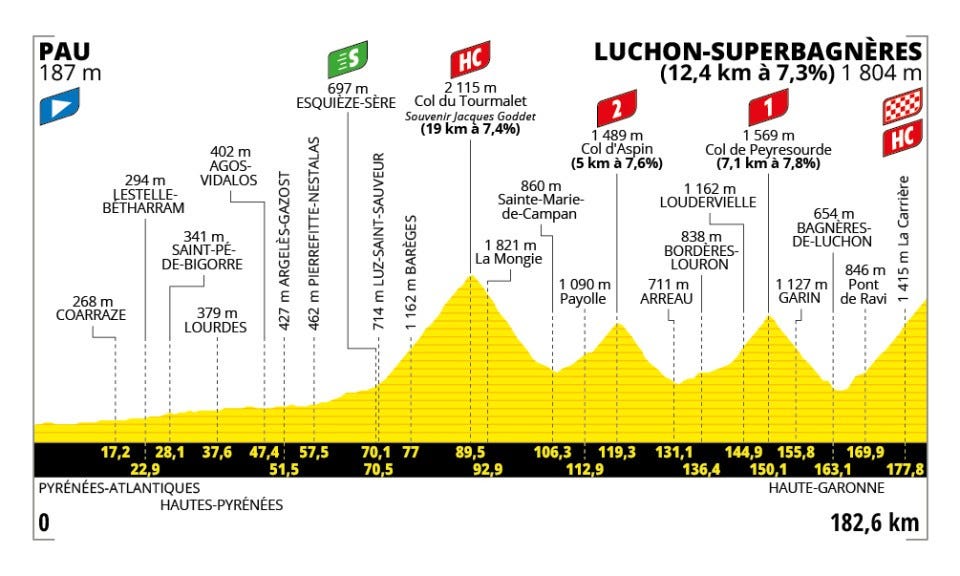
Le Tour De France
Greg Lemond fans will find the route of Stage 14 quite familiar, as it mirrors the course taken by Stage 13 of the 1986 Tour de France. On that day France’s Bernard Hinault attacked too early, and fell apart late in the stage. Lemond, Hinault’s teammate–and greatest rival–started the day more than five minutes behind the Frenchman but won the stage, gaining over four minutes on Hinault in the process. Lemond would go on to win the Tour, an exploit documented in the book and the documentary called Slaying the Badger.
Related Story
As Stage 13 did in 1986, this year’s Stage 14 begins in Pau and heads back into the Pyrenees for a 182.6-kilometer ride featuring almost 5,000 meters of elevation gain spread over four of the most famous ascents in the Pyrenees, starting with the 2,115m Hors catégorie Col du Tourmalet, the highest Pyrenean summit in this year’s Tour.
Once the climbing begins there will be few chances to recover: the summits come in close succession with little time in the valley to grab supplies from team cars or just relax for a bit on wider, flatter roads.
The final climb to the Luchon Superbagnères Ski Resort is “only” a Category 1 ascent, but that won’t matter much: at 12.4 kilometers and with an average gradient of 7.3-percent, it’s going to do some damage–especially after three hard days of intense racing through Pyrenees.
Depending on how the GC battle plays out on Stages 12 and 13, this could end up being be the best chance for a rider to score a Pyrenean stage victory from a breakaway, so expect the first 90 minutes of the stage to be fierce as riders who have fallen out of GC contention, polka dot jersey contenders, and a few teammates from the GC contenders’ teams try and get up the road.
The battles to win the stage and to create more gaps on the General Classification will be intense. And–just as we saw in 1986–by the end of the day there might only be a handful of riders left with a chance of winning the Tour.
Stage 16Montpellier to Mont Ventoux
Tuesday, July 22nd – (171.5KM)

Le Tour De France
A trip to Mont Ventoux is always special, and this year, for the first time since 2016, when the Tour tried to finish at the top of the mountain, but was thwarted by high winds–a stage in the Tour de France will (hopefully) finish at the summit.
Stage 16 is essentially a stage in two parts: the first 155 kilometers will serve as a long, gradual warm-up, something the riders might appreciate as they re-adjust to racing following the Tour’s second Rest Day. Aside from an early breakaway, there won’t be much action on the road as the peloton rolls its way toward the final climb. But this area is still one of the most beautiful in France, so the scenery will be stunning. (And wine enthusiasts might enjoy watching the race pass through the day’s Intermediate Sprint in Châteauneuf-du-Pape.)
But while it might take them a few hours to get there, the race will have heated up by the time the riders pass through Bedouin, a town not far from the base of Mont Ventoux that often finds itself overflowing with cyclists wishing to make the trek to the summit.
An extinct volcano, the Hors catégorie ascent is pretty hard to miss, and its bald, windswept summit will loom on the horizon as the riders approach. The 15.7-kilometer climb begins in a forest, and the road ascends steeply right from the bottom. The grade softens for a kilometer as the riders pass the Chalet de Renard restaurant about 10 kilometers into the climb, but the road gets steeper almost immediately after the riders turn left to begin the long, exposed drag to the summit.
While quiet at first, the final 45 minutes of Stage 16 should be spectacular–as stages that tackle Mont Ventoux always are. It will be easy for the peloton to keep the breakaway close throughout the first few hours of the stage, setting the stage for a GC showdown on the final climb. You can bet that everyone will want to score this prestigious stage victory–especially Pogačar, a rider who seems eager to add as many impressive wins to his resume as he can.
Stage 18Vif to Courchevel Col de la Loze
Thursday, July 24th – (171.5KM)
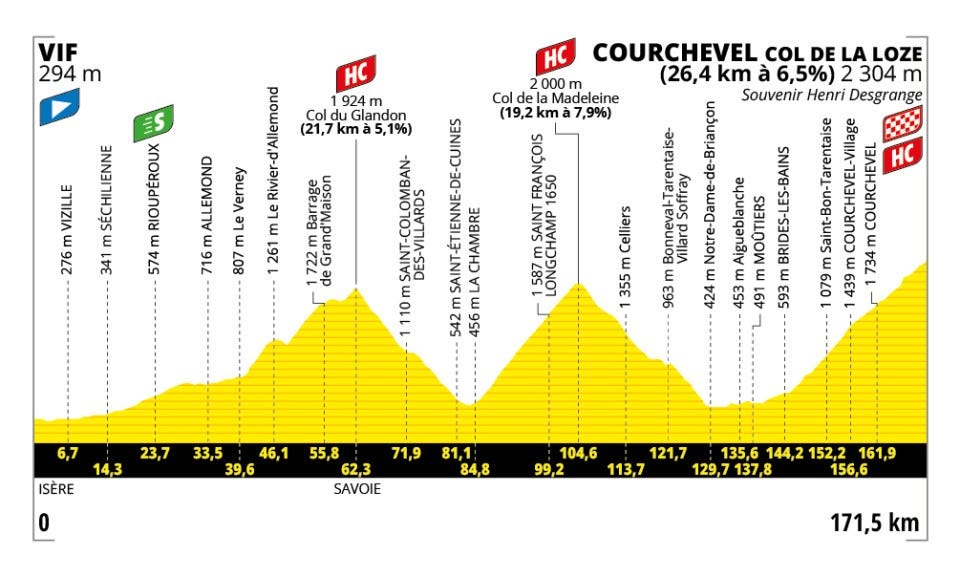
Le Tour De France
With over 5,000m of elevation gain, three “Beyond Category” summits, and a finish atop the 2,304-meter Col de la Loze, Stage 18 is the hardest stage in the 2025 Tour de France.
The day begins in a valley, but the climbing begins immediately as the road drags up to the base of the first of the day’s three major summits: the Hors catégorie Col du Glandon, a 21.7-kilometer climb with a 5.1-percent average gradient.
Like many stages through the mountains, Stage 18 is another stage that should begin with an intense battle to make the early breakaway. If one hasn’t formed on the long false flat out the valley, then it will certainly emerge on the lower slopes of the Glandon.
The long descent from the summit of the Glandon is the only rest the riders will get as the next climb–the Hors catégorie Col de la Madeleine–begins right away. Much steeper than the Glandon, the Madeleine is an 19.2KM ascent with average gradient of 7.9-percent. At the summit, the riders will hit 2,000m of elevation for the second time in the stage–but not the last. The air will be thin, and their lungs will certainly feel it.
The day’s final challenge is the 2,304m Col de la Loze, another Hors catégorie climb, a relatively new ascent that the Tour visited in 2020 and 2023. 2025 will mark the first time that a stage climbs to the summit from the Courchevel side of the pass; it’s supposedly “easier” than the route taken by the race in 2020 and 2023, but we don’t know how at 26.4KM ascent with a 6.4-percent average gradient can ever be considered “easy.” As it usually does, the final few kilometers of the climb take the riders onto a bike path, where the road gets really steep.
Stage 18 is a day that Pogačar has probably had marked in his calendar since the Tour route was announced last October. In 2023, the Slovenian cracked on the lower slopes of the climb, famously telling his team director, “I”m gone. I’m dead.” He finished the stage more than seven minutes behind on the Tour’s General Classification. So you can count on Pogačar to be out for revenge on the Col de la Loze, the climb that killed his chances of winning a third Tour in 2023.
Well, there you have it: six stages you don’t want to miss. You can handle that, right?
And remember to save time for a visit Bicycling.com for post-stage analysis and updates from me and the rest of the Bicycling team. Let us help you make sense of whatever unfolds.
Since getting hooked on pro cycling while watching Lance Armstrong win the 1993 U.S. Pro Championship in Philadelphia, longtime Bicycling contributor Whit Yost has raced on Belgian cobbles, helped build a European pro team, and piloted that team from Malaysia to Mont Ventoux as an assistant director sportif. These days, he lives with his wife and son in Pennsylvania, spending his days serving as an assistant middle school principal and his nights playing Dungeons & Dragons.
